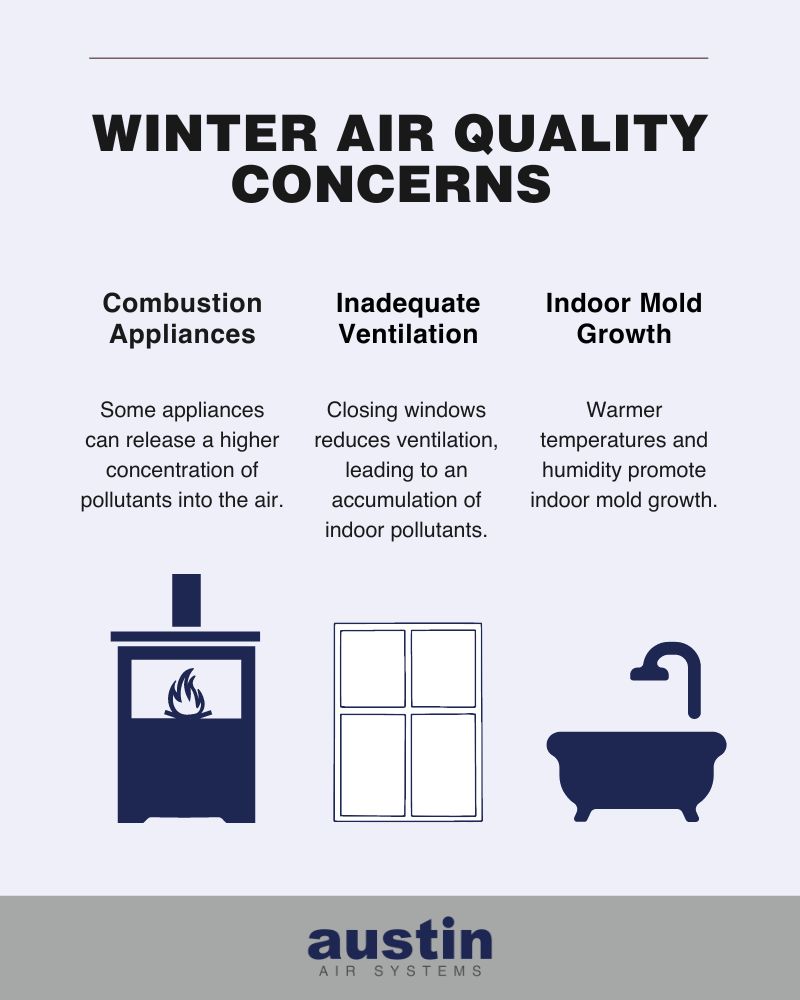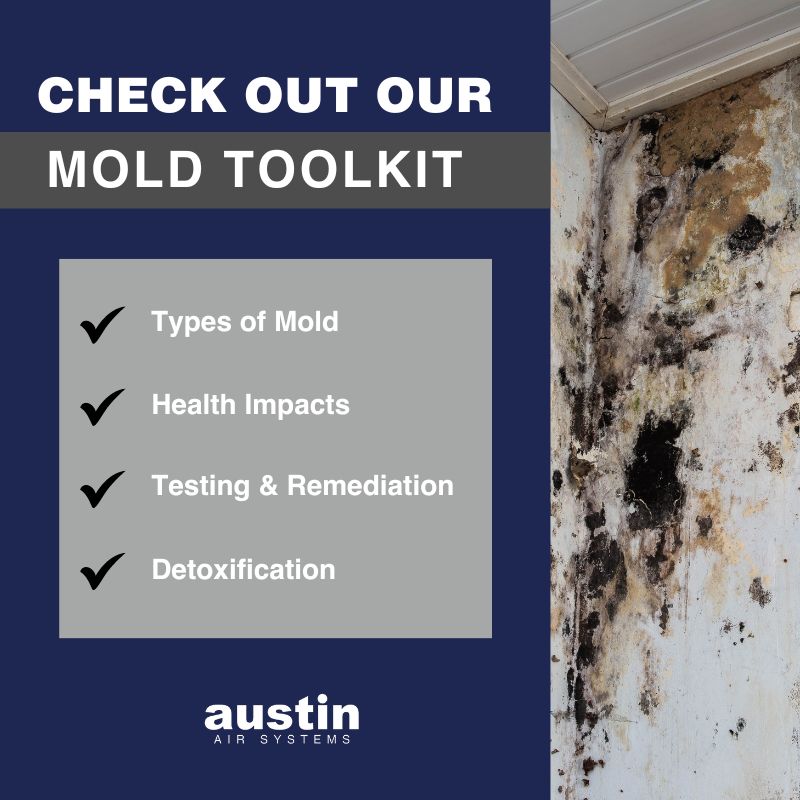During the past few weeks, most of the United States and parts of Canada have been hammered with brutal winter weather. This has included blinding snow and blizzards in some regions, freezing rain in other areas, and bitterly cold temperatures in areas that aren’t equipped for such extremes.1 Some of this is standard for the Northeast but it’s not the norm in hard-hit places like the Pacific Northwest or the South.
This isn’t a fluke, we can count on more wacky winter weather to come. Many experts agree the severity and geographical reach of these episodes is increasing.2 And along with the joys of slippery roads, high heating bills, and power outages comes another lingering winter hazard: poor air quality, both outdoors and indoors. Nobody – besides winter sports enthusiasts – needed another reason to love the cold, dark winter but we’ll discuss how you can be mindful of these issues.
First, let’s explore some of the specifics.
Winter’s Impact on Outdoor Air Quality
It’s a basic fact that summer is when air pollution is typically at its worst due to various chemical reactions that occur in sunlight and heat. There is also a lot more activity with pollen. Additionally, there is more construction taking place which kicks up dirt and other contaminants that become airborne. But winter combines a unique blend of natural conditions with human activity and together, they impact air quality.
Stagnant Air Conditions: One of the primary causes of winter air quality issues is the fact that cold air is more stagnant (or stationary) which prevents it from mixing with cleaner air and diluting. Instead, the colder air traps pollutants near the ground, causing harmful substances to accumulate. This also exacerbates existing air quality problems.3
While ozone is typically the worst in summer, some high-elevation areas in the Western U.S. see ozone levels rise in winter. This is due to a combination of temperature inversion (another type of stagnant air) trapping pollutants like nitrogen oxides (NOx) and volatile organic compounds (VOCs) closer to the ground. When skies are sunny and the ground is covered with snow, the NOx and VOCs undergo chemical reactions and result in an increase in ozone in those regions.4
Pollution from Indoor Heat Sources: The use of heating appliances in winter doesn’t just increase your energy costs. Many heat sources, like gas furnaces, lead to higher levels of carbon monoxide in the air. In some areas, wood-burning stoves and fireplaces are the primary indoor heating sources, which emit harmful pollutants, including particulate matter (PM), VOCs, and polycyclic aromatic hydrocarbons (PAHs).
Traffic-Related Emissions: A great way to beat the cold is to let your vehicles idle for a while to warm up before you hit the road. In Buffalo, where Austin Air’s operations are based, remote car starters were an extremely popular Christmas gift for drivers whose cars didn’t already have this feature. It’s so appreciated that it’s becoming standard – along with heated seats.
Although this practice provides a lot of comfort in cold climates, it also leads to higher emissions of pollutants from vehicles – like nitrogen oxides and PM. In fact, some areas with high air pollution actually have laws forbidding extended idling.
**************************************************
This combination of emissions from indoor heating, increased use of fossil fuels, and reduced dispersion of contaminants due to stagnant air conditions all contribute to higher levels of air pollution. The extra outdoor pollutants enter homes through windows and doors, impacting indoor air quality (IAQ).
Indoor Air Quality Concerns In Winter
In addition to contaminants from the outdoors and increased time spent indoors, IAQ is impacted in winter by heating practices, reduced ventilation, and mold.5
Increased Use of Combustion Appliances: As previously mentioned, the use of heating appliances such as gas furnaces, wood-burning stoves, and fireplaces increases in winter, and they emit byproducts into the outdoors. Even with proper use, there is going to be an increase of contaminants like carbon monoxide (CO) and nitrogen dioxide (NO2).
Additionally, incomplete combustion in poorly maintained or improperly ventilated appliances can release a higher concentration of pollutants into the indoor air, posing a serious risk to human health. Forced air heating systems have their own issues, they can distribute dust and allergens throughout the home.
Inadequate Ventilation: In winter, people seal their homes tightly to conserve heat, even purchasing plastic sheeting to cover the windows. While this is energy-efficient and can save money while making a space more comfortable, it reduces ventilation and indoor pollutants accumulate. Stale air and an insufficient exchange of outdoor and indoor air contribute to poorer indoor air quality.
Additionally, indoor allergens from pet dander, dust mites, and potted plants that have been brought inside during winter will all be more concentrated with reduced ventilation.
Winter often involves more time spent indoors, which often leads to increased use of household cleaning products. Many of these products contain VOCs and other harmful chemicals, negatively impacting indoor air quality, and decreased ventilation will cause them to linger.
Indoor Mold Growth: Warmer indoor temperatures combined with increased humidity levels from everyday activities like cooking and bathing, plus low ventilation, can create conditions conducive to indoor mold growth. Mold spores, when airborne, are respiratory irritants that contribute to allergies and respiratory issues.
Breathe Freely This Winter
Improving indoor air quality during winter requires a combination of preventive measures and awareness of potential sources of pollution. It’s essential to maintain proper ventilation, regularly service heating appliances, control indoor humidity levels, open windows to air out the home each week, and to use natural household products with a low VOC content – among other practices.
To learn more about mold issues indoors and how to remediate them, take a look at the Austin Air Mold Toolkit.
Do you have a gas-powered furnace or hot water heater? Consider this your sign to check that your carbon monoxide detector is working properly. If you can’t remember the last time you changed the batteries, that might mean it’s time for a refresh.
Another very important safety tip for all you folks in warmer climates who have seen an increase of below-freezing weather in recent years: if you don’t have central heat or your power is out and the weather is freezing, DO NOT use an oven or stove to produce heat. This is dangerous for multiple reasons. Don’t do it.
But all in all, even in the best of times, indoor air can have two to five times more pollutants than outdoor air. To ensure the safety of your loved ones, consider additional air filtration from Austin Air. We are the only clinically proven air cleaner on the market, boasting a combination of true, medical-grade HEPA and activated carbon.
REFERENCES
1 Weekend of Arctic storms could break low-temperature records in U.S. heartland. (2024, January 13). PBS NewsHour. https://www.pbs.org/newshour/nation/weekend-of-arctic-storms-could-break-low-temperature-records-in-u-s-heartland.
2 Licker, R. (2023, April 25). How Is Climate Change Affecting Winter Storms in the US? The Equation. https://blog.ucsusa.org/rachel-licker/how-is-climate-change-affecting-winter-storms-in-the-us/.
3 How Weather Affects Air Quality. (n.d.). Center for Science Education. UCAR. https://scied.ucar.edu/learning-zone/air-quality/how-weather-affects-air-quality.
4 UtahAir – Ozone. (n.d.). https://health.utah.gov/utahair/pollutants/O3/#gsc.tab=0.
5 Staying Safe from Indoor Air Pollution This Winter. (2023 December 11). https://www.lung.org/blog/indoor-air-quality-winter.


